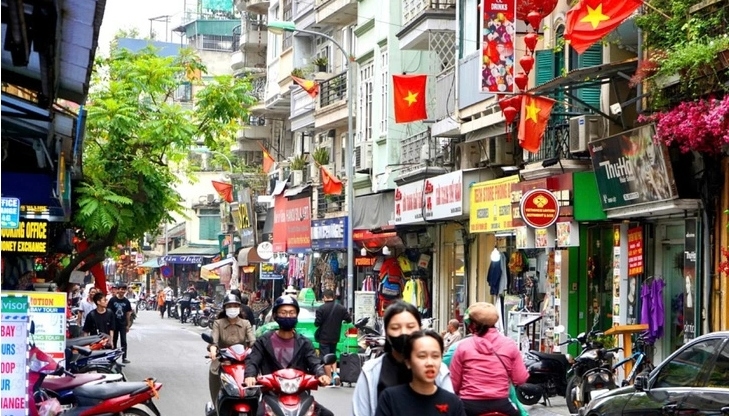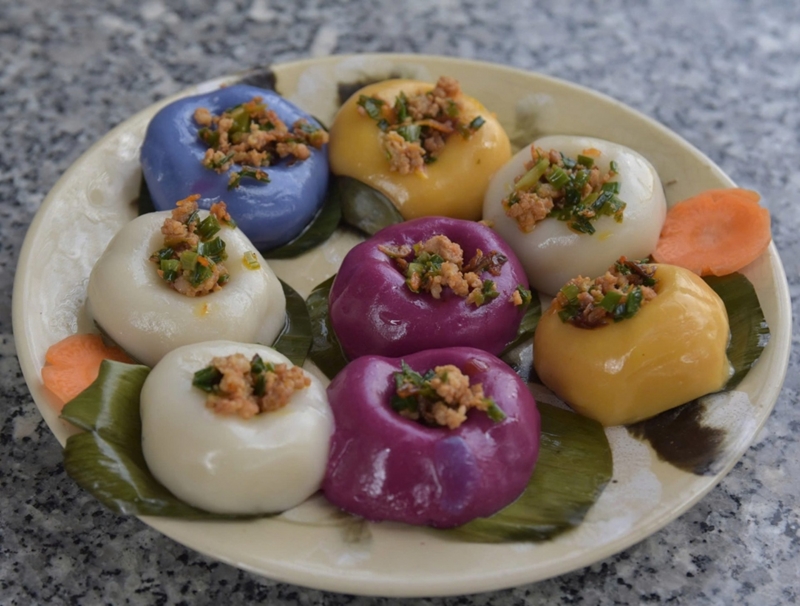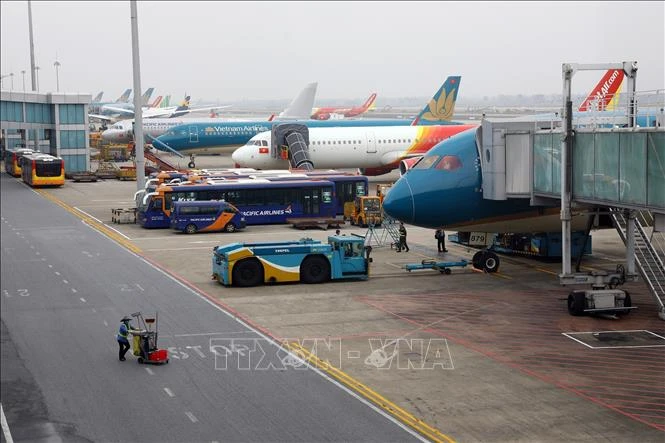 |
| Hanoi's Old Quarter (Photo: Michelin Guide) |
According to the information given by Michelin, the Old Quarter is the best place for foodies to stay.
“Not only does it have the best street food, but the neighbourhood is also packed with temples, pagodas, churches, lakes, parks and cafes,” it noted.
In the morning of the first day discovering Hanoi, Michelin recommends that visitors should work up an appetite with a brisk loop around Hoan Kiem lake before then ducking into the Old Quarter and seeking out beef noodle soup at Phở Bò Ấu Triệu, a MICHELIN Guide 2024 Bib Gourmand restaurant on a street which runs parallel to St. Joseph Cathedral.
After breakfast, visitors can then take time to admire the 19th-century cathedral before settling into a café which overlooks the cathedral’s weatherworn façade.
“When the hunger pangs return, wander up the road for a lesser-known Vietnamese noodle dish. Miến Lươn Đông Thịnh, another MICHELIN Guide 2024 Bib Gourmand hole-in-the-wall eatery, has been serving glass noodles with eel, greens, crushed peanuts and deep-fried shallots for more than four decades,” it revealed.
During the rest of the afternoon, visitors can look out for Bach Ma Temple, one of Hanoi’s oldest places of worship, as well as Thuoc Bac street, where they can find decades-old shops selling traditional medicine.
According to the prestigious guide, tourists can finish their day with Chả Cá, a pan-fried fish with turmeric, noodles, and greens cooked right at the table at Chả Cá Thăng Long at 6B Duong Thanh street. The eatery is so popular it even has establishments on the same street.
“Put your trust in our MICHELIN inspectors, who prefer the location at 6B Duong Thanh Street, a townhouse built over a century ago,” it stressed.
Visitors should also try Bánh Cuốn, steamed wet rice paper rolls with minced pork, at Bánh Cuốn Bà Xuân restaurant to begin their second day in Hanoi.
Michelin shared that lunch for many locals includes Bun Cha, one of the city’s favourite dishes. Tuyết Bún Chả 34, a MICHELIN Guide 2024 Bib Gourmand street food joint, serves extraordinarily generous portions of rice vermicelli noodles, grilled pork, and fresh green herbs.
“This bustling eatery is close to Truc Bach Lake, Tran Quoc Pagoda and Quan Su Temple, all important sights with long histories. Spend the afternoon exploring, and don’t forget to have a drink by the water at sunset,” it suggested.
For dinner, Michelin recommended Ốc Di Tú restaurant on 44C Quan Thanh street which serves a dizzying variety of high-quality sea food delicacies in basic surroundings, such as prawns, clams, and cockles.
“MICHELIN inspectors were particularly impressed with the huge melo melo sea snails grilled with scallions and fried garlic and Venus clams with lemongrass, chili and pineapple,” it concluded.
Banh it tran: A culinary tradition from central Vietnam
Banh it tran, known as Vietnamese sticky rice dumpling, is a delightful dish that perfectly balances soft, chewy dough with a rich, savory filling, reported Saigon Times.
 |
| A dish of colorful banh it tran (Photo: Gia Nghi) |
This traditional snack is a must-try for anyone looking to experience the authentic flavors of central Vietnam.
At the heart of banh it tran is its simple yet satisfying composition. The dough, made from a blend of glutinous rice flour, rice flour, salt, and water, is soft, chewy, and slightly sticky. Some cooks enhance the dough’s flavor by adding coconut milk, which gives it a richer, more indulgent taste.
What truly sets banh it tran apart is its filling. The most common variety features a savory mix of mashed mung beans, minced pork, shrimp, wood ear mushrooms, onions, salt, and pepper. These ingredients are sautéed together, creating a harmonious blend of flavors and textures. There is also a sweet version, often filled with sweetened mung beans or coconut.
Once the filling is prepared and cooled, it is rolled into small balls. The dough is divided into equal portions, each flattened and wrapped around the filling before being shaped back into a ball. Before steaming, the cakes are lightly coated with oil to ensure a smooth texture. They are then steamed for about 15 minutes until fully cooked.
When served, banh it tran is typically topped with scallion oil, fried onions, and toasted shrimp flakes. It is accompanied by a small bowl of chili fish sauce and pickled carrots and daikon, adding a tangy and spicy contrast to the rich, savory dumplings.
Banh it tran is more than just a snack; it is a symbol of togetherness and celebration. Family members often gather to knead the dough, prepare the filling, and assemble the cakes, making it a dish steeped in tradition and cultural significance.
Airlines add flights, ramp up security for National Day holidays
Vietnamese airlines are bracing for a surge in air travel during the upcoming National Day (September 2) holidays, with flight schedules expanding to accommodate the rush, reported VNA.
 |
| At Hanoi-based Noi Bai international airport (Photo: VNA) |
Between August 30 and September 3, a total of 4,257 flights are set to crisscross the nation's skies, marking a 3% increase from the previous week and a 3.5% jump from the same period last year.
Domestic routes will bear the brunt of the holiday rush, with an average of 600 flights per day, a 2.8% year-on-year increase. International routes, while seeing a slight 2% dip compared to the pre-holiday week, remain up by 5.1% year on year.
The North-South corridor, linking Hanoi, Da Nang, and Ho Chi Minh City, will be particularly bustling. Flight frequencies are set to soar by 8% from the previous week and 14.9% from the same period last year, with an average of 241 daily flights.
 |
| Photo for illutration (Source: VOV) |
Popular tourist hotspots are not exempt from the holiday hustle. Destinations like Vinh, Binh Dinh, Da Lat, Nha Trang, and Phu Quoc will see increased flight activity, with airlines operating an average of 171 flights per day to these localities - a 2% increase from the week before. Other domestic routes will witness a 4% rise, with 187 flights per day.
The Civil Aviation Authority of Vietnam (CAAV) reported that over 600,000 seats will be up for grabs on domestic routes during the holidays, averaging 122,000 seats daily. This signifies a 5% increase from the pre-holiday week and a 1.5% hike year on year.
To safeguard passengers and ensure smooth operations, the CAAV will adopt enhanced level-1 aviation security control measures at airports and air traffic service facilities.
Ha Long Bay - Cat Ba Archipelago recognised as World Geological Heritage
The International Union of Geological Sciences (IUGS) has recognised Ha Long Bay - Cat Ba Archipelago in the northern province of Quang Ninh and neighbouring Hai Phong City as a world geological heritage site, reported VNA.
 |
| Ha Long Bay - Cat Ba Archipelago recognized as World Geological Heritage (Source: VNA) |
According to Associate Professor Dr Tran Tan Van, former director of the Vietnam Institute of Geosciences and Mineral Resources under the Ministry of Natural Resources and Environment (MoNRE), who has participated in compiling two world heritage dossiers related to outstanding global geological values, and directly prepared documents for the regonistion of the Ha Long Bay - Cat Ba Archipelago by the IUGS, the site, together with 99 others in 53 countries in world, is included on the IUGS's world geological heritage list thanks to the outstanding global values of geological history and karst geomorphology.
The IUGS is scheduled to announced a list of 100 newly-recognised geological heritage sites at the 37th International Geological Congress 2024 in Busan Republic of Korea, from August 25 to 31.
Ha Long Bay - Cat Ba Archipelago includes all stages of the marine submergence of tropical karst as well as three main types of caves - ancient marine frog-jaw caves, ancient karst caves and frog-jaw caves. The Ha Long Bay represents the later stages of the marine subduction while the Cat Ba Archipelago adds important geological values to the heritage through its patterns of the terrestrial and intertidal stages.
In 1994, Ha Long Bay in Quang Ninh province was recognised by the United Nations Educational, Scientific and Cultural Organisation (UNESCO) as a world natural heritage site with outstanding universal aesthetic value. In 2000, Ha Long Bay was recognised by UNESCO as a world natural heritage site for the second time with outstanding universal geological and geomorphological value.
On September 16, 2023, at the 45th Session of the World Natural Heritage Committee, the UNESCO recognised Ha Long Bay - Cat Ba Archipelago as the first Vietnamese inter-provincial site as as a world natural heritage site.
The recognition of Ha Long Bay - Cat Ba Archipelago as an international geological heritage by the IUGS affirms the value of this heritage.
The appearance of Ha Long Bay - Cat Ba Archipelago and its unique and famous geological and geomorphological values today are the result of a regional tectonic movement that lasted more than 500 million years./.